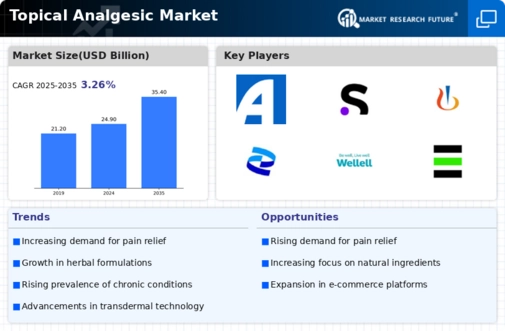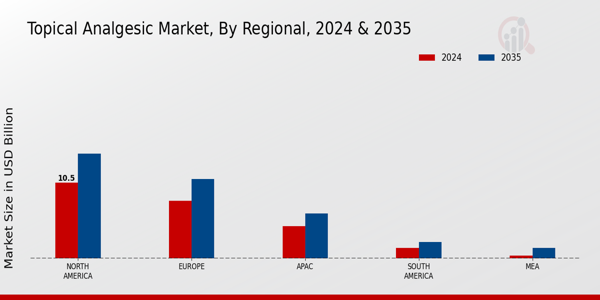Growing Aging Population
The demographic shift towards an aging population significantly influences the Global Topical Analgesic Market Industry. Older adults are more susceptible to various health issues, including chronic pain and musculoskeletal disorders. According to the United Nations, the global population aged 60 years and older is expected to reach 2.1 billion by 2050. This demographic trend is likely to increase the demand for topical analgesics, as older adults often prefer non-invasive pain relief methods. Consequently, the market is anticipated to expand, with projections indicating a growth to 35.4 USD Billion by 2035, driven by the need for effective pain management solutions.
Market Growth Projections
The Global Topical Analgesic Market Industry is poised for substantial growth in the coming years. Projections indicate that the market will reach 24.9 USD Billion in 2024, with an anticipated increase to 35.4 USD Billion by 2035. This growth trajectory suggests a compound annual growth rate of 3.25 percent from 2025 to 2035. Factors contributing to this expansion include the rising prevalence of chronic pain, an aging population, and advancements in formulation technology. As the market evolves, it is likely to attract new players and foster innovation, ultimately benefiting consumers seeking effective pain relief solutions.
Rising Prevalence of Chronic Pain
The increasing incidence of chronic pain conditions globally drives the Global Topical Analgesic Market Industry. Conditions such as arthritis, neuropathic pain, and fibromyalgia are becoming more prevalent, affecting millions of individuals. For instance, the World Health Organization indicates that chronic pain affects approximately 20 percent of adults worldwide. This growing patient population necessitates effective pain management solutions, leading to a heightened demand for topical analgesics. As a result, the market is projected to reach 24.9 USD Billion in 2024, reflecting the urgent need for innovative pain relief options.
Advancements in Formulation Technology
Innovations in formulation technology play a crucial role in shaping the Global Topical Analgesic Market Industry. The development of novel delivery systems, such as transdermal patches and microneedles, enhances the efficacy and user experience of topical analgesics. These advancements allow for improved penetration of active ingredients, leading to faster and more effective pain relief. As manufacturers invest in research and development to create more effective formulations, the market is likely to witness substantial growth. The introduction of advanced products is expected to attract a broader consumer base, further driving market expansion.
Rising Demand for Non-Opioid Pain Management Solutions
The increasing demand for non-opioid pain management solutions significantly influences the Global Topical Analgesic Market Industry. With growing concerns regarding opioid addiction and side effects, healthcare providers and patients are seeking alternative pain relief options. Topical analgesics, which offer localized relief without systemic side effects, are gaining popularity. This trend is likely to accelerate market growth as more individuals opt for safer pain management strategies. The market's expansion is underscored by the projected growth to 35.4 USD Billion by 2035, reflecting the shift towards non-opioid alternatives.
Increased Awareness and Acceptance of Topical Analgesics
There is a notable rise in awareness and acceptance of topical analgesics among consumers, which positively impacts the Global Topical Analgesic Market Industry. Educational campaigns and healthcare provider recommendations have contributed to a better understanding of the efficacy and safety of these products. As consumers become more informed about non-invasive pain relief options, they are more likely to choose topical analgesics over oral medications. This shift in preference is expected to bolster market growth, with a projected compound annual growth rate of 3.25 percent from 2025 to 2035, reflecting the evolving landscape of pain management.



















Leave a Comment